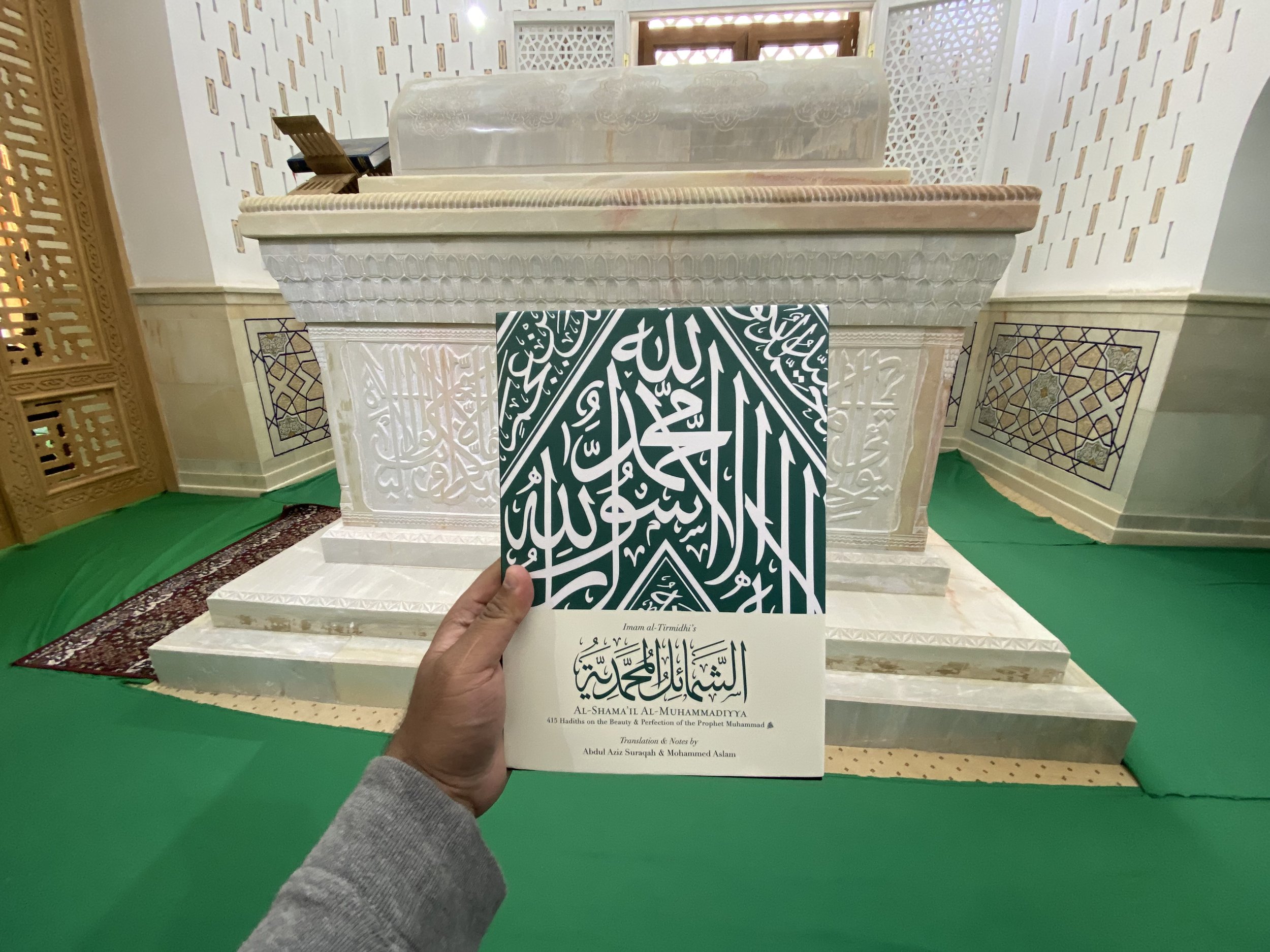This article is adapted from the introduction to IGI’s edition of Imam al-Tirmidhi’s Al-Shama’il al-Muhammadiyya, published in 2020.
His full name is Muhammad ibn ‘Isa ibn Sawra ibn Musa ibn al-Dahhad al-Sulami al-Tirmidhi, from the city of Tirmidh, located in present-day southern Uzbekistan. It is also said that his name was Muhammad ibn ‘Isa ibn Yazid ibn Sawra ibn al-Sakan.
Imam al-Tirmidhi was born in the month of Dhu al-Hijja in the year 209 AH (824 CE). His grandfather Sawra was from the city of Merv in present-day Turkmenistan, and later moved to the village of Bugh.
Imam al-Tirmidhi’s grandfather came from the city of Merv, which was once among the largest cities in the world, but is now abandoned
Some historians say that Imam al-Tirmidhi was born blind, whereas Imam al-Dhahabi and other scholars mention that he became blind later in life due to many years of rigorous travel in pursuit of sacred knowledge, as well as frequent weeping in awe of Allah.
His Pursuit of Sacred Knowledge
Imam al-Tirmidhi began seeking sacred knowledge in his early twenties in his home village of Bugh, and eventually studied under scholars in Khorasan, Makkah, Medina, Basra, Kufa, Wasit, and Ray (present-day Tehran, Iran). In each of these lands, he heard hadith from narrators and hadith masters.
Although he did not travel to Egypt or the Levant (Sham), he recorded narrations, from the hadith scholars of those lands via intermediaries.
His Teachers
Imam al-Tirmidhi studied under an extraordinary number of teachers. He was a direct student of some of the most famous masters of hadith, including:
Imam al-Tirmidhi narrated seventy-five reports in his Sunan on the authority of Imam al-Bukhari, and quoted his teacher more than one hundred times in his work assessing hadith narrators (al-Jarh wa al-Ta’dil).
Imam al-Bukhari is reported to have said to Imam al-Tirmidhi, “I have benefited from you more than you have benefited from me.”
As for Imam Muslim, although Imam al-Tirmidhi heard many narrations from him, he only narrated a single hadith from his teacher in his Sunan (hadith 690).
As for Imam Abu Dawud, Imam al-Tirmidhi, heard many narrations from him, and narrated five hadith from him in his Sunan (hadith 468, 733, 3148, 3962, and 4158).
List of His Teachers
Imam al-Tirmidhi traveled in Khorasan in pursuit of knowledge, and studied with many teachers there
Beyond the three great masters of hadith mentioned above, Imam al-Dhahabi wrote that Imam al-Tirmidhi narrated on the authority of numerous other teachers, including:
Muhammad ibn ‘Amr al-Sawwaq al-Balkhi
Ahmad ibn Mani’
Bishr ibn Mu’adh al-’Aqadi
Hasan ibn Ahmad ibn Abi Shu’ayb
Abu ‘Ammar Husayn ibn Hurayth
Ma’mar ibn ‘Abdillah ibn Mu’awiya al-Jumahi
‘Abd al-Jabbar ibn al-’Ala’
Abu Kurayb
‘Ali ibn Hujr
‘Ali ibn Sa’id ibn Masruq al-Kindi
‘Imran ibn Musa al-Qazzaz
Muhammad ibn Abban al-Mustamli
Muhammad ibn Humayd al-Razi
Muhammad ibn ‘Abd al-A’la
Muhammad ibn Rafi’
Muhammad ibn ‘Abd al-’Aziz ibn Abi Razma
Muhammad ibn ‘Abd al-Malik ibn Abi al-Shawarib
Muhammad ibn Yahya al-’Adani
Nasr ibn ‘Ali
Harun al-Hammal
Hannad ibn al-Sarri
Abu Hammam al-Walid ibn Shuja’
Yahya ibn Habib ibn ‘Arabi
Yahya ibn Darsat al-Basri
Yahya ibn Talha al-Yarbu’i
Yusuf ibn Hammad al-Ma’ni
Ishaq ibn Musa al-Khatmi
Ibrahim ibn ‘Abdillah al-Harawi
Suwayd ibn Nasr al-Marwizi
IGI’s edition of Imam al-Tirmidhi’s Al-Shama’il al-Muhammadiyya has become the standard edition of this text in both Arabic and English worldwide.
His students
Imam al-Tirmidhi’s most famous students included:
Abu Hamid al-Marwazi
Ahmad ibn ‘Ali al-Muqri’
Ahmad ibn Yusuf al-Nasafi
Abu al-Harith Asad ibn Hamduwayhi al-Nasafi
Hammad ibn Shakir al-Warraq
Dawud ibn Nasr ibn Suhayl al-Bazdawi
Abu al-Hasan ‘Ali ibn ‘Umar ibn al-Taqi ibn Kulthum
Abu Ja’far Muhammad ibn Sa’id al-Harawi
Makhul ibn al-Fadl al-Nasafi
Makki ibn Nuh al-Nasafi al-Muqri’
Haytham ibn Kulayb al-Shashi
His Virtues & Rank in Scholarship
Imam al-Tirmidhi was held in universal esteem bu scholars for both his hadith mastery and his personal piety.
Hafiz al-Mizzi said of him, “He is one of the distinguished imams and hadith masters, and one by whom Allah benefited the Muslims.”
Shaykh Aslam discusses Imam al-Tirmidhi’s relationship with his teacher Imam al-Bukhari, and the latter’s influence on al-Shama’il al-Muhammadiyya
Imam al-Hakim said, “I heard ‘Umar ibn ‘Allak say, ‘Bukhari died and left no one in Khorasan like Abu ‘Isa [al-Tirmidhi] in knowledge, memorization, piety, and worldly renunciation. He wept until he became blind and remained in that condition for years.’”
Imam Ibn Kathir said, “He was one of the imams of hadith in his age and has a number of famous compilations, such as al-Jami’, al-Shama’il, Asma’ al-Sahaba, and others. The book al-Jami’ is one of the six [hadith] works that the scholars refer to.”
Abu Ya’la al-Khalili said, “He is a narrator of probity and precision (thiqa), and there is consensus regarding his status. He was known for his trustworthiness and knowledge.”
Imam al-Dhahabi recorded that Imam al-Tirmidhi said, “I compiled this work [al-Jami’] and presented it to the scholars of the Hejaz, Iraq, and Khorasan, and they were pleased with it. Anyone who has this book in his home, it is as if he has the Prophet speaking in his home.”
His Works
Imam al-Tirmidhi wrote:
al-Jami’ (The Compendium)
al-Shama’il al-Muhammadiyya (The Muhammadan Qualities)
al-’Ilal (The Defects)
Asma’ al-Sahaba (The Names of the Companions)
al-Jarh wa al-Ta’dil (Creditation and Discreditation)
Imam al-Tirmidhi also authored other works no longer available to us, including:
Kitab al-Zuhd (The Book of Worldly Renunciation)
Kitab al-Tarikh (The Book of History)
al-Asma’ wa al-Kuna (On Names and Agnomens)
al-Athar al-Mawqufa (The Reports Whose Chains End with Companions)
His Death
Imam al-Tirmidhi died on a Monday, the 13th of Rajab 279 AH (892 CE), in his home village of Bugh.
May Allah Most High have mercy upon him, be pleased with him, and admit him to the loftiest Gardens of Paradise in the intimate company of the Prophet Muhammad ﷺ.
The Imam’s masjid and maqam are located near the city of Tirmiz, and to this day are active and well known in the local community. In early 2022, several members of the Imam Ghazali Publishing team were blessed to visit the masjid and maqam. The pictures below were taken that visit.
IGI’s translation of Imam al-Tirmidhi’s al-Shama’il al-Muhammadiyya has revived interest in this landmark collection of hadith on the qualities & character of the Prophet ﷺ.















